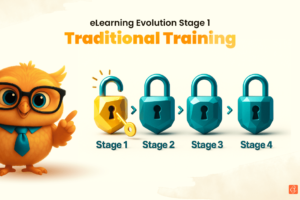
Internal vs External Learning Systems, Easy to Explain?
For those individuals who would rather read a summary of the post than the entire post, see below. A.I. created this. I reviewed it to verify and validate the information as accurate. The summary presents key takeaways. To read the entire POST, scroll down after the summary.
Please note that this is a work in progress, but I hope you see value in it. Feel free to write your feedback in the comments area.
There is no simple answer regarding the differences between internal and external learning systems. The landscape is complex with various types of learning systems, including Learning Management Systems (LMS), Learning Platforms, Talent Development Platforms, Learning Experience Platforms (LXP), and Mentoring Platforms, each serving different audiences such as employees, customers, clients, partners, and distributors.
Internal Learning Systems
Internal systems focus on onboarding, skilling, and upskilling employees. Key features include:
- Skill Development: Tools for reskilling employees, offering coaching, mentorship, and opportunities to practice new skills.
- Content Specificity: Content delivery aligned with job roles and personal development goals.
- Skill Ratings and Job Roles: Mechanisms to rate skills and align job roles with opportunities, requiring managerial oversight for approvals.
Challenges include employees’ assumptions regarding opportunities’ approvals and a lack of deep engagement tools, such as integrative video communication for assessments.
External Learning Systems
In contrast, external systems emphasize customer training and engagement, characterized by:
- Multi-tenant Capabilities: Ability to serve various external audiences.
- E-commerce Features: Systems that support customer transactions, particularly in training environments.
- Data-Driven Metrics: Insights centered around customer training, helping organizations track performance and completion rates.
Key Differences
- Focus Areas: Internal systems prioritize employee development, while external systems cater to clients and customers.
- Metrics Usage: Internal metrics revolve around learning paths for employees, whereas external metrics focus on customer engagement and training effectiveness.
- Functionality: Internal systems might lack certain features for external audiences, like extensive e-commerce capabilities.
COMPLETE ARTICLE
There is no simple answer. It is not a cut-and-dry retort.
There are different types of learning systems—LMS, Learning Platform, Talent Development Platform, LXP, Mentoring Platform, mentoring in an internal system (for employees, regardless of whether they are frontline, at a plant—blue collar, if you will, and those in the office—even remote).
External are your customers, clients, partners, distributors.
They can be an association.
You could have an LMS or another learning system offering multi-tenant – think parent-child, portal-sub portal angle.
This allows you, the entity, to have internal and external audiences —perhaps multiple internal audiences—thus eliminating all those other LMSs at your company and, heck, lots of externals.
If that isn’t enough, you could purchase a system that heavily angles internal and goes external, and vice versa.
Ubiquitous plays strongly here.
This gets back to the whole internal vs. external LMS debate (I will use this term simply because it is the largest segment in the learning system space, and even when people seek an LXP, nowadays, they are angling into an LMS with LXP functionality).
How do you define, or let’s get to the point, the differences between internal and external?
This says, “Okay, where should you go?”
Tell me, define it, and explain it in easy-to-understand terminology.
Internal
Onboarding your employees involves skilling and upskilling.
For those who recognize the AI is coming, reskill those you want to do so.
Coach them.
Mentor them.
Place them into an opportunity to practice skills for them.
Provide them with content that aligns with their job role or skills they need or want to develop.
The former, with the assigned angle and/or content, is often needed.
Skill ratings.
Job roles with opportunities (as some systems offer, and the number is growing).
The opportunities are internal and still require the manager to review this to either green-light or not.
Another manager or department head may review this, pushing the two to one category.
The manager initially has a say, and it is foolish to assume they will say, “Okay, you are perfect for the role; you are approved – i.e., hired. “
There are way too many variables at play.
Worse, the employee presumes that by the green light for the opportunity – they have the gig.
Systems today are missing the picture – those that zero in on internal.
I applied for the opportunity based on skills ratings and the skills developed that aligned highest—assuming that is how the system sees it nowadays with vendors leveraging AI—and I submitted.
I get accepted.
The next step should be a video integration, where the manager of said opportunity can talk to the learner and ask questions OR, at the minimum, go text and have the manager ask deep-thinking questions, eliminating the ability for the employee to use, say, the free ChatGPT with a cut-and-paste.
Today, AI is unable to respond to deep thinking.
This would be a straightforward way—frankly, they are this way, for now—to show that the system is truly internal.
A powerful mechanism.
A missed opportunity.
Internal Tricky
The combo systems—those that go internal and external, depending on the higher percentage of the audience base—may skew.
That is changing because the vendors themselves are not familiar enough with the external audience—which is often the case here—and as a result, the system skews more to the employee side.
For me, it is self-evident.
I can tell within the first 10 minutes or less.
The buyer, though, is unaware of the combo audience based on the said percentage.
One would think the feature set identifies the skew.
And you would be right, up to a point.
If said vendor has played, let’s say, over 90% employee focus and now wants to jump into external – a segment that overwhelmingly vendors wish to into the space.
Then, the vendor enters, ignoring the pitfalls, even if they lack the functionality to achieve growth.
They land clients, everybody does – even big names.
A Case Study
Okay, not really.
I will name one vendor who pushes the apparent narrative that it is all about customer training.
SkillJar
I like the system, but on the metrics side, you will see data points tied to completed learning—a tell-tale sign of an internal audience.
Completed means assigned.
And it is only applicable to an external audience – if it is tied to a certification program.
That data point should be visible on the primary data screen.
This tells the head of the association or company that has a certification program a comparison of where that individual or individuals are if the certification is not professional—i.e., a professional-focused association instead of a trade association.
There is a vast difference.
Pluralsight, for example, provides such data—it is clear to anyone looking at it, from the certification of content completion and program steps to the various data points.
SkillJar, though, doesn’t have it.
Assigned learning?
I am an employee who needs to know how to use an MRI machine – the customer/client of the company who makes MRI machines, and thus, that training goes to the employees (a typical scenario).
The employee already knows how to do X and Y and is curious about Z, but maybe only certain pieces.
The employee then will go in and out, focusing on what pieces.
There isn’t a timeframe for completion.
Therefore, the assigned punch shouldn’t be visible.
On the other hand, SJ offers many data points/metrics for customer training.
Which begs the question.
Why not show that on the main dashboard that someone sees?
A combo crux.
Internal – can you tell the difference?
Yes.
To a point.
Ignore all the content assigned to a specific group or just one human – everyone can do that.
Ignore the ability for one group to see X catalog versus another group.
There are only maybe three functions that a vendor who plays strongly—and I mean over 90% externally—will lack or be seriously weak at.
But if you want rule approvals for multiple administrators or something similar, a system that is even heavily internal may not have them.
Does it scream that the system is not focused internally?
The earlier example of missing functionality of, let’s say, even CEUs or CPDs to be assigned to convent and visible is not universal to every system, regardless of target audience.
No, it just means they lack it.
The List of Internal Differences
- Goal Management
- Workflows—Customer training vendors who have plunged into internal may have it, but it will not be as strong as an internal system —that said, plenty of internal systems lack it.
- Workflows that are expanding far more than current – this is a growing trend with internal – Learn Amp has it. Impressive.
- Job Roles are intertwined with skills and content and are becoming tied to external sources, too. However, this is not universal. The job roles are the key here. Combos really have it—again, it is not universal.
- Job Role driven
- Strong level with skill ratings – If a vendor plays internally at a greater level, they will usually have this. Skill ratings are becoming universal, except when the vendor is 98 to 100% only customer training – external. Combos are all over the map with this. For example, Docebo has it and plays stronger externally – audience-wise – but feature sets are a perfect example of trying to do both segments. They have skill ratings, but compared to a Cornerstone, it isn’t at that tier. Neither do several other vendors who are at a Cornerstone level.
- Skills Management—From skill mapping to skills capabilities, internal will always be stronger here. Combos can be solid, but they haven’t, in my opinion, achieved a level of heavy internal. And a combo that is more external but plays internal, who has it, has yet to penetrate at a solid level.
- Metrics are all around L&D – That said, being great at it versus yuck is common. It seems to be either you are good at doing it or poor. Jekyll and Hyde here. I always note that if you can’t look at your data and get a firm idea of your learning story, which you should, it is a colossal failure. Anyway, this is a key piece I always look at, and I can tell in less than two minutes whether they are heavy internal and good at it or solid or strong internal and horrible at it. External – their metrics are not even close to this, even in the Combo space. If they are only External, their metrics are all around external.
- Roles tied to Opportunities—clear. The funny thing is that a vendor who is one of the few attending LXPs out there, as in that is the core, has the roles, skills, and opportunities available. Combos—yeah, it can be brutal out there.
Who does the best job as an internal drive platform?
Any TDP—which means Talent Development Platform—if they say they truly are, then yeah, even if they do not pronounce it as such. But you can see internal, internal, and internal as the forefront—well, you get it.
- Learn Amp—They are all about internal. You can do external with them, sure. But their focus and core are internal. That should be a huge hint when you call yourself an employee development platform.
- Juno Journey – If a vendor says they are an L&D platform – huge hint – they are core internal.
- Cornerstone LMS, even Cornerstone Learn – Internal heavy. Again, you can do external; you get the point if a vendor offers multi-tenant and an extended enterprise option (the term should be customer training). You can do internal only with multi-tenants like you have dozens of LOBs or want to streamline all your systems under them. They now include a mentoring-heavy piece in their LMS – at no charge. Mentoring is internal – down the road, I see it externally, too – as a combo.
- BizLMS plus BizSkills – Internal only. I would do it with both platforms. L&D is only here.
- Docebo—As my rankings show, they are really good and skew internal, but they do have enough functionality for external. I would put them in play for internal. They are a legitimate threat.
- Access Learning – Focus is on compliance – total internal
- Acorn PLMS – Internal. Internal – hey, did I mention internal?
- Kallidus – Heavy internal. It plays externally, too – but this screams internal.
- SuccessFactors LMS—They are as internal as you can get, despite being underwhelming as a system.
- Workday Learning—See above. They can meet with SuccessFactors and hang out together. Who brought the hot dogs?
- Zensai Learn365 – Internal heavy. You may have heard of LMS365 – that is, well, sort of them, before acquisition.
- Absorb LMS—Combo: They can go internal. So why put them here? They have a strong set for internal, yet they play solid external. Personally, I think external for them can be quite good. They are only a tiny list of Combos that are equal feature-wise. The list of the top tiers is here: Docebo and Absorb.
Internal Combos
Here are my top picks, who do an above-average job with most of the functionality. As strong as the others—well, that is up for interpretation.
- Spark Learn—It’s all about front-line workers, including blue-collar workers. This is internal. Feature-wise, it’s not strong in many of those areas. Okay, they miss a few. But yeah, internal.
- Schoox – They started to enter the customer training segment, which is odd because they are heavily tailored around internal. I wouldn’t buy them for customer training.
- KREDO – Internal heavy. They dispute this, and you can go external, but I believe it is more internal.
- Thirst—Internal focus. Is it a true LXP? I’m not seeing it. It has a lot of functionality, but from a serious LXP segment standpoint, nope.
- Degreed – Internal. The first vendor to offer job roles tied to opportunities in the industry. It is legit and genuinely an LXP.
External
It is a pretty simple differential compared to the above because there are a few focused areas when I look at external – heavily skewed towards it.
- Multi-tenant, with many options beyond what an internal can do. The challenge here is those combo systems—they can be a lot like an external, depending on the growth of one segment versus another.
- E-Commerce—Customer Training will have it—whether you have to pay to use the service is a different question. In Combo land, the majority offer it—I mean Combo, which means both sides. The top ones on the Combo side do a far better job here.
- Assigned Learning isn’t the focus here. If they offer it, well, it means they offer it. Nowadays, heavy CT offers it—not by choice; those darn Combos are causing it.
- Metrics—The King Kong—All the metrics are around customer training. You can look at a customer training platform, take a look at those metrics, and it will tell you its learning story. If the vendor plays heavily in association land, then their metrics will have a solid set for external but a solid set for internal. Again, Combo here. This is one way to say, “Okay, this system is heavy for customer training.”
Other functionality-wise, those Combos have brought the whole “your site can look like a place to buy products” thing into play. Back in the day, only external focus offered it.
Now, some Combos do as well, and plenty do.
Again, some are good, but some should not offer it.
The Best for external
- Eurekos is 100% focused external. Plus, they bill monthly, so you pay only for those in it—rare but plays well into the customer training side.
- Thought Industries – 98% external. Super strong here.
- Absorb LMS—Combo, but I like them more for external use. They can also go internal. The system goes about 50-50 here. I see them as a vendor who can do some serious damage in the external space, so I slide them here. If you want them for internal use, they have all the items noted above.
- D2L Brightspace—Their set for external is excellent. Their metrics are called Performance Management—an awful idea. The metrics are all around external. Why not call it advanced analytics? It’s top for the association space, too.
- Intellum – Always played heavily in external.
- Learning Cart – External full throttle.
- NetExam – External.
- Docebo – Combo land. They play more on the external side, but as noted earlier, they can do very well on the internal side. Can the top Combos do this? Can the rest? Well, a middle pack, the rest? Forget about
- TalentLMS—External—Solid. They push stronger externals, but metrics are a mixed bag. They do compete heavily in the external space. They say free forever when you search for them – it is highly misleading.
- LearnUpon – Combo – They do a good job with external, hence the slide here.
- Knowledge Anywhere—Under the Radar IMO, they get lost in the shuffle but are heavily external. They lack the metric strength, though. Legit competitor to Talent LMS. Personally, I think they are better.
- Brainier – See above. I think they can do better here because they are external. Sometimes, vendors get lost because others take up all the space. Despite them being good at external. Metrics need serious improvement. Aother legit competitor to Talent LMS. They like KA above are similar in price point to Talent.
- 360Learning—Another Combo; I think they are more potent in external. They will probably tell me otherwise.
Next Tier
- Skill Jar—They do have some metrics for externals, but the idea that they are all about external is erroneous, in my opinion. See the case study above for more information on the other part.
- Plenty of others – but yeah, I’m sure you found them.
LearnOps by Cognota is training operations, and Training Orchestra is training management.
Two examples play a specific role, so I didn’t place them internally.
That is their fit, feature-wise, not.
NovoEd – I really like them, but while they play internally and externally, as once a cohort platform, they are a bit challenging as to where they fit.
Plus, they have a couple of new solutions coming out soon—this summer—that will significantly differentiate them from the rest of the market.
These solutions will open up new possibilities for learning systems, blurring the lines between internal and external systems.
Bottom Line
The question.
How can you clearly and easily define this complex landscape’s internal and external systems?
You can’t.
Nor should you.
If someone says, “I have the perfect answer,” it’s a sign they haven’t fully explored the segment.
We need to be open to different interpretations.
With so many vendors out there, my list is at the top of the list—after all, there are over 1,400 learning systems in the world.
Thrive is open to where they fit the best.
I see them as internal.
However, as a vendor, they can say no; we are a better fit for external.
Cypher learning slides into where they best fit.
They are not strong enough for internal or external – yet as a Combo, they do a good job – from a system standpoint.
The training ops, training management, cohort-specific, mentoring, and coaching platforms are just the tip of the iceberg.
A vendor may call itself an LMS and then change its name to say it is a learning platform—open to interpretation—when it is an LMS.
Part of the problem when trying to say here is how to say it, specifically so everyone gets it.
Life is like that.
AI is an excellent example.
It’s the future, yet a company that says it is environmentally focused or committed to the environment, climate, or whatever uses AI.
AI, though, requires a lot of power, about the same as nearly four coal plants.
It requires water, an essential commodity that we are losing daily.
Yet a necessity for AI.
As a company, you are doing this when using AI, which is the opposite of your commitment.
It isn’t so easy.
This is why there isn’t a straightforward response on the best way to communicate this to everyone, both internally and externally.
And honestly,
Does it really matter?
E-Learning 24/7
Source link



